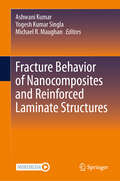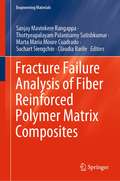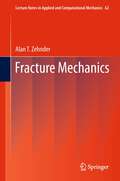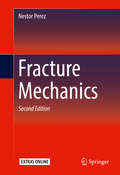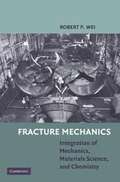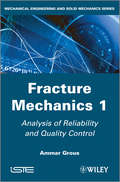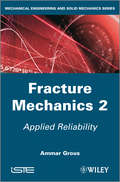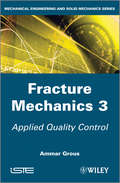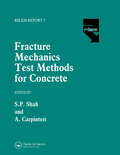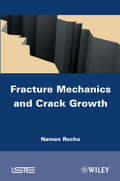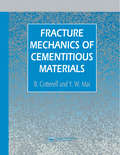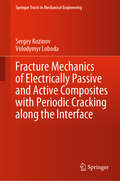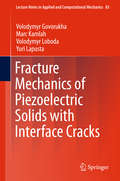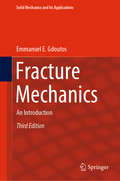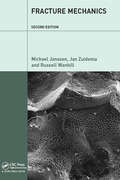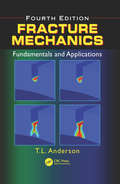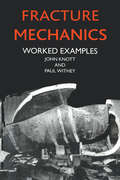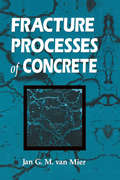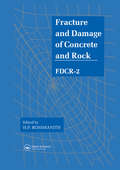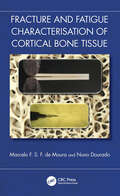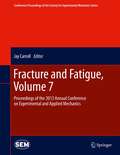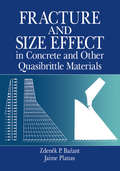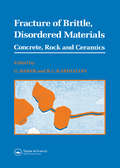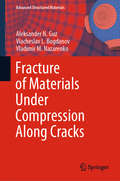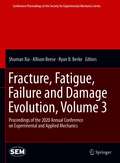- Table View
- List View
Fracture Behavior of Nanocomposites and Reinforced Laminate Structures
by Ashwani Kumar Yogesh Kumar Singla Michael R. MaughanThis contributed volume is designed for fundamental understanding of fracture behavior of composites applied in core industrial sectors such as mechanical, electronics, Automotive, civil structures, and aerospace research and fills the gap of knowledge on fracture analysis. The book is primarily written for senior undergraduates, graduate students, and academic researchers in above mentioned fields.
Fracture Failure Analysis of Fiber Reinforced Polymer Matrix Composites (Engineering Materials)
by Suchart Siengchin Sanjay Mavinkere Rangappa Thottyeapalayam Palanisamy Satishkumar Marta Maria Moure Cuadrado Claudia BarileThis book presents a unified approach to fracture behavior of natural and synthetic fiber-reinforced polymer composites on the basis of fiber orientation, the addition of fillers, characterization, properties and applications. In addition, the book contains an extensive survey of recent improvements in the research and development of fracture analysis of FRP composites that are used to make higher fracture toughness composites in various applications.The FRP composites are an emerging area in polymer science with many structural applications. The rise in materials failure by fracture has forced scientists and researchers to develop new higher strength materials for obtaining higher fracture toughness. Therefore, further knowledge and insight into the different modes of fracture behavior of FRP composites are critical to expanding the range of their application.
Fracture Mechanics
by Alan T. ZehnderFracture mechanics is a vast and growing field. This book develops the basic elements needed for both fracture research and engineering practice. The emphasis is on continuum mechanics models for energy flows and crack-tip stress- and deformation fields in elastic and elastic-plastic materials. In addition to a brief discussion of computational fracture methods, the text includes practical sections on fracture criteria, fracture toughness testing, and methods for measuring stress intensity factors and energy release rates. Class-tested at Cornell, this book is designed for students, researchers and practitioners interested in understanding and contributing to a diverse and vital field of knowledge.
Fracture Mechanics
by Nestor PerezThe second edition of this textbook includes a refined presentation of concepts in each chapter, additional examples; new problems and sections, such as conformal mapping and mechanical behavior of wood; while retaining all the features of the original book. The material included in this book is based upon the development of analytical and numerical procedures pertinent to particular fields of linear elastic fracture mechanics (LEFM) and plastic fracture mechanics (PFM), including mixed-mode-loading interaction. The mathematical approach undertaken herein is coupled with a brief review of several fracture theories available in cited references, along with many color images and figures. Dynamic fracture mechanics is included through the field of fatigue and Charpy impact testing.
Fracture Mechanics
by Robert P. WeiFracture and "slow" crack growth reflect the response of a material (i. e. , its microstructure) to the conjoint actions of mechanical and chemical driving forces and are affected by temperature. There is therefore a need for quantitative understanding and modeling of the influences of chemical and thermal environments and of microstructure, in terms of the key internal and external variables, and for their incorporation into design and probabilistic implications. This text, which the author has used in a fracture mechanics course for advanced undergraduate and graduate students, is based on the work of the author's Lehigh University team whose integrative research combined fracture mechanics, surface and electrochemistry, materials science, and probability and statistics to address a range of fracture safety and durability issues on aluminum, ferrous, nickel, and titanium alloys and ceramics. Examples from this research are included to highlight the approach and applicability of the findings in practical durability and reliability problems.
Fracture Mechanics 1: Analysis of Reliability and Quality Control
by Ammar GrousThis first book of a 3-volume set on Fracture Mechanics is mainly centered on the vast range of the laws of statistical distributions encountered in various scientific and technical fields. These laws are indispensable in understanding the probability behavior of components and mechanical structures that are exploited in the other volumes of this series, which are dedicated to reliability and quality control.The author presents not only the laws of distribution of various models but also the tests of adequacy suited to confirm or counter the hypothesis of the law in question, namely the Pearson (x2) test, the Kolmogorov-Smirnov (KS) test, along with many other relevant tests.This book distinguishes itself from other works in the field through its originality in presenting an educational approach which aims at helping practitioners both in academia and industry. It is intended for technicians, engineers, designers, students, and teachers working in the fields of engineering and vocational education. The main objective of the author is to provide an assessment of indicators of quality and reliability to aid in decision-making. To this end, an intuitive and practical approach, based on mathematical rigor, is recommended.
Fracture Mechanics 2: Applied Reliability (Wiley-iste Ser. #737)
by Ammar GrousThis second book of a 3-volume set on Fracture Mechanics completes the first volume through the analysis of adjustment tests suited to correctly validating the justified use of the laws conforming to the behavior of the materials and structures under study.This volume focuses on the vast range of statistical distributions encountered in reliability. Its aim is to run statistical measurements, to present a report on enhanced measures in mechanical reliability and to evaluate the reliability of repairable or unrepairable systems. To achieve this, the author presents a theoretical and practice-based approach on the following themes: criteria of failures; Bayesian applied probability; Markov chains; Monte Carlo simulation as well as many other solved case studies.This book distinguishes itself from other works in the field through its originality in presenting an educational approach which aims at helping practitioners both in academia and industry. It is intended for technicians, engineers, designers, students, and teachers working in the fields of engineering and vocational education. The main objective of the author is to provide an assessment of indicators of quality and reliability to aid in decision-making. To this end, an intuitive and practical approach, based on mathematical rigor, is recommended.
Fracture Mechanics 3: Applied Quality Control (Wiley-iste Ser. #736)
by Ammar GrousThis third book of a 3-volume set on Fracture Mechanics adds a pragmatic and supportive character to the previous volumes by focusing on case studies using corrected exercises that teachers, students or engineers will find extremely useful. Due to the wide themes approached in this series, it can also be used to organize work in this field in a new way, as well as in the maintenance of industrial plants.Several cases of sampling plans and their applications in industry are presented, as well as several solved case studies on the main indicators of capability according to ISO/TS 16949, ISO 8258 and FORD.This book distinguishes itself from other works in the field through its originality in presenting an educational approach which aims at helping practitioners both in academia and industry. It is intended for technicians, engineers, designers, students, and teachers working in the fields of engineering and vocational education. The main objective of the author is to provide an assessment of indicators of quality and reliability to aid in decision-making. To this end, an intuitive and practical approach, based on mathematical rigor, is recommended.
Fracture Mechanics Test Methods For Concrete
by S. P. Shah A. CarpinteriCompares currently used methods in determining concrete toughness and presents recommended test procedures with theories and models for describing cracking and fracturing phenomena. Effects of loading rate, temperature and humidity are also examined. Well referenced and illustrated, this book is filled with practical technical information for mater
Fracture Mechanics and Crack Growth (Wiley-iste Ser.)
by Naman RechoThis book presents recent advances related to the following two topics: how mechanical fields close to material or geometrical singularities such as cracks can be determined; how failure criteria can be established according to the singularity degrees related to these discontinuities. Concerning the determination of mechanical fields close to a crack tip, the first part of the book presents most of the traditional methods in order to classify them into two major categories. The first is based on the stress field, such as the Airy function, and the second resolves the problem from functions related to displacement fields. Following this, a new method based on the Hamiltonian system is presented in great detail. Local and energetic approaches to fracture are used in order to determine the fracture parameters such as stress intensity factor and energy release rate. The second part of the book describes methodologies to establish the critical fracture loads and the crack growth criteria. Singular fields for homogeneous and non-homogeneous problems near crack tips, v-notches, interfaces, etc. associated with the crack initiation and propagation laws in elastic and elastic-plastic media, allow us to determine the basis of failure criteria. Each phenomenon studied is dealt with according to its conceptual and theoretical modeling, to its use in the criteria of fracture resistance; and finally to its implementation in terms of feasibility and numerical application. Contents 1. Introduction.Part 1: Stress Field Analysis Close to the Crack Tip2. Review of Continuum Mechanics and the Behavior Laws.3. Overview of Fracture Mechanics.4. Fracture Mechanics.5. Introduction to the Finite Element Analysis of Cracked Structures.Part 2: Crack Growth Criteria6. Crack Propagation.7. Crack Growth Prediction in Elements of Steel Structures Submitted to Fatigue.8. Potential Use of Crack Propagation Laws in Fatigue Life Design.
Fracture Mechanics of Cementitious Materials
by B. Cotterell Y.W. MaiThe application of fracture mechanics to cementitious materials allows the investigation of many important factors relating to the durability of these materials. This new book provides a comprehensive and readable exposition of this subject and is written by two of the world's foremost experts.
Fracture Mechanics of Electrically Passive and Active Composites with Periodic Cracking along the Interface (Springer Tracts in Mechanical Engineering)
by Volodymyr Loboda Sergey KozinovThis book offers a comprehensive and timely review of the fracture behavior of bimaterial composites consisting of periodically connected components, i.e. of bimaterial composites possessing periodical cracks along the interface. It first presents an overview of the literature, and then analyzes the isotropic, anisotropic and piezoelectric/dielectric properties of bimaterial components, gradually increasing the difficulty of the solutions discussed up to the coupled electromechanical problems. While in the case of isotropic and anisotropic materials it covers the problems generated by an arbitrary set of cracks, for the piezoelectric materials it focuses on studying the influence of the electric permittivity of the crack’s filler, using not only a simple, fully electrically permeable model, but also a physically realistic, semi-permeable model. Throughout the analyses, the effects of the contact of the crack faces are taken into account so as to exclude the physically unrealistic interpenetration of the composite components that are typical of the classical open model. Further, the book derives and examines the mechanical and electromechanical fields, stress and electric intensity factors in detail. Providing extensive information on the fracture processes taking place in composite materials, the book helps readers become familiar with mathematical methods of complex function theory for obtaining exact analytical solutions.
Fracture Mechanics of Piezoelectric Solids with Interface Cracks
by Volodymyr Govorukha Marc Kamlah Volodymyr Loboda Yuri LapustaThis book provides a comprehensive study of cracks situated at the interface of two piezoelectric materials. It discusses different electric boundary conditions along the crack faces, in particular the cases of electrically permeable, impermeable, partially permeable, and conducting cracks. The book also elaborates on a new technique for the determination of electromechanical fields at the tips of interface cracks in finite sized piezoceramic bodies of arbitrary shape under different load types. It solves scientific problems of solid mechanics in connection with the investigation of electromechanical fields in piezoceramic bodies with interface cracks, and develops calculation models and solution methods for plane fracture mechanical problems for piecewise homogeneous piezoceramic bodies with cracks at the interfaces. It discusses the "open" crack model, which leads to a physically unrealistic oscillating singularity at the crack tips, and the contact zone model for in-plane straight interface cracks between two dissimilar piezoelectric materials. It also investigates the model of a crack with electro-mechanical pre-fracture zones. The formulated problems are reduced to problems of linear relationship, which correspond to different crack models, and their exact analytical solutions are found. The book presents in detail the expressions for stress and electric displacement intensity factors, as well as for the energy release rate. The influence of the electric permittivity of the crack, the mechanical load and the electric field upon the electro-elastic state, as well as the main fracture mechanical parameters, are analyzed and clearly illustrated. This book addresses postgraduate students, university teachers and researchers dealing with the problems of fracture mechanics of piezoelectric materials, as well as engineers who are active in the analysis of strength and durability of piezoelectric constructions.
Fracture Mechanics: An Introduction (Solid Mechanics and Its Applications #263)
by Emmanuel E. GdoutosThis book discusses the basic principles and traditional applications of fracture mechanics, as well as the cutting-edge research in the field over the last three decades in current topics like composites, thin films, nanoindentation, and cementitious materials.Experimental methods play a major role in the study of fracture mechanics problems and are used for the determination of the major fracture mechanics quantities such as stress intensity factors, crack tip opening displacements, strain energy release rates, crack paths, crack velocities in static and dynamic problems. These methods include electrical resistance strain gauges, photoelasticity, interferometry techniques, geometric and interferometry moiré, and the optical method of caustics.Furthermore, numerical methods are often used for the determination of fracture mechanics parameters. They include finite and boundary element methods, Green’s function and weight functions, boundary collocation, alternating methods, and integral transforms continuous dislocations.This third edition of the book covers the basic principles and traditional applications, as well as the latest developments of fracture mechanics. Featuring two new chapters and 30 more example problems, it presents a comprehensive overview of fracture mechanics, and includes numerous examples and unsolved problems. This book is suitable for teaching fracture mechanics courses at the undergraduate and graduate levels. A “solutions manual” is available for course instructors upon request.
Fracture Mechanics: Fundamentals and Applications
by Russell Wanhill Michael Janssen Jan ZuidemaThis book covers both theoretical and practical aspects of fracture mechanics and integrates materials science with solid mechanics.
Fracture Mechanics: Fundamentals and Applications, Fourth Edition
by Ted L. AndersonFracture Mechanics: Fundamentals and Applications, Fourth Edition is the most useful and comprehensive guide to fracture mechanics available. It has been adopted by more than 150 universities worldwide and used by thousands of engineers and researchers. This new edition reflects the latest research, industry practices, applications, and computational analysis and modeling. It encompasses theory and applications, linear and nonlinear fracture mechanics, solid mechanics, and materials science with a unified, balanced, and in-depth approach. Numerous chapter problems have been added or revised, and additional resources are available for those teaching college courses or training sessions. Dr. Anderson’s own website can be accessed at www.FractureMechanics.com.
Fracture Mechanics: Worked Examples
by John Knott Paul WitneyThis book is aimed at those in both industry and academic institutions who require a grounding not only in the basic principles of this important field but also in the practical aspects of evaluating fracture mechanics parameters.
Fracture Processes of Concrete (New Directions in Civil Engineering #12)
by Jan G.M. van MierDespite tremendous advances made in fracture mechanics of concrete in recent years, very little information has been available on the nature of fracture processes and on reliable test methods for determining parameters for the different models. Moreover, most texts on this topic discuss numerical modeling but fail to consider experimentation. This book fills these gaps and synthesizes progress in the field in a simple, straightforward manner geared to practical applications.
Fracture and Damage of Concrete and Rock - FDCR-2
by H. P. RossmanithThis book forms the Proceedings of the International Conference held in Vienna in November 1992 dealing with ageing, fatigue and fracture of concrete and concrete structures. Special sections cover demolition and recycling, and anchorage engineering. As well as selected international contributions, five specially invited plenary papers are included
Fracture and Fatigue Characterisation of Cortical Bone Tissue
by Marcelo F. de Moura Nuno DouradoFracture and Fatigue Characterisation of Cortical Bone Tissue is a key guide to bone fracture and fatigue, focusing on quasi-static and fatigue-fracture characterisation of cortical bone tissue. Discussing the fundamental aspects of fracture mechanics and fatigue, which are applicable to many orthotropic materials, this book examines novel, cutting-edge approaches to analyse and model bone fracture and fatigue.As the population ages across the globe, bone fracture and fatigue has become a fundamental part of mechanical and biomedical engineering research. Beginning with a thorough description of fracture mechanics and fatigue, the book describes non-linear fracture mechanics under quasi-static and fatigue analyses. It goes on to present a cohesive zone modelling method which is appropriate for mode I, mode II and mixed-mode I+II loading. Presenting the latest research, this book describes cutting-edge fracture tests, new methods for data reduction purposes and numerical models based on cohesive zone modelling. This book is key to aiding both students and professionals in applying fundamental theories and methods to cortical bone tissue.The book will be of interest to students and professionals working in mechanical engineering and biomedical engineering, including work on quasi-static fracture, fracture under fatigue loading, artificial bones and fracture mechanisms.
Fracture and Fatigue, Volume 7: Proceedings of the 2013 Annual Conference on Experimental and Applied Mechanics
by Jay CarrollFracture and Fatigue, Volume 7: Proceedings of the 2013 Annual Conference on Experimental and Applied Mechanics, the seventh volume of eight from the Conference, brings together contributions to this important area of research and engineering. The collection presents early findings and case studies on a wide range of areas, including: Microstructural Effects in Fatigue & Fracture Fracture of Interfaces Fracture of Composites and Interface Cracks Fatigue & Fracture: Environmental & Loading Effects Fracture & Digital Image Correlation
Fracture and Size Effect in Concrete and Other Quasibrittle Materials (New Directions In Civil Engineering Ser. #16)
by Zdenek P. Bazant Jaime PlanasFracture and Size Effect in Concrete and Other Quasibrittle Materials is the first in-depth text on the application of fracture mechanics to the analysis of failure in concrete structures. The book synthesizes a vast number of recent research results in the literature to provide a comprehensive treatment of the topic that does not give merely the facts - it provides true understanding. The many recent results on quasibrittle fracture and size effect, which were scattered throughout many periodicals, are compiled here in a single volume. This book presents a well-rounded discussion of the theory of size effect and scaling of failure loads in structures. The size effect, which is the most important practical manifestation of fracture behavior, has become a hot topic. It has gained prominence in current research on concrete and quasibrittle materials. The treatment of every subject in Fracture and Size Effect in Concrete and Other Quasibrittle Materials proceeds from simple to complex, from specialized to general, and is as concise as possible using the simplest level of mathematics necessary to treat the subject clearly and accurately. Whether you are an engineering student or a practicing engineer, this book provides you with a clear presentation, including full derivations and examples, from which you can gain real understanding of fracture and size effect in concrete and other quasibrittle materials.
Fracture of Brittle Disordered Materials: Concrete, Rock and Ceramics
by B. L. Karihaloo G. BakerThis book derives from the invited IUTAM Symposium in September 1993. The contributions discuss recent advances in fracture mechanics studies of concrete, rock, ceramics and other brittle disordered materials at micro and structural levels. It draws together research and new applications in continuum, damage and fracture mechanics approaches.
Fracture of Materials Under Compression Along Cracks (Advanced Structured Materials #138)
by Aleksander N. Guz Viacheslav L. Bogdanov Vladimir M. NazarenkoThis book addresses the problems of fracture mechanics of materials with cracks under the loading directed along the cracks. It considers two non-classical fracture mechanisms, namely the fracture of bodies compressed along cracks and the fracture of materials with initial (residual) stresses acting in parallel to the surfaces of cracks location, and presents new approaches (also including combined one) developed in the framework of three-dimensional linearized mechanics of deformable bodies. It then discusses the results of studies on two- and three-dimensional problems for various configurations of crack locations in isotropic and anisotropic materials, and based on these results, critically evaluates the accuracy and applicability limits of the “beam approximation” approach, which is widely used to study various problems of the fracture of bodies under compression along parallel cracks.
Fracture, Fatigue, Failure and Damage Evolution , Volume 3: Proceedings of the 2020 Annual Conference on Experimental and Applied Mechanics (Conference Proceedings of the Society for Experimental Mechanics Series)
by Shuman Xia Ryan B. Berke Allison BeeseFracture, Fatigue, Failure and Damage Evolution, Volume 3 of the Proceedings of the 2020 SEM Annual Conference & Exposition on Experimental and Applied Mechanics, the third volume of seven from the Conference, brings together contributions to this important area of research and engineering. The collection presents early findings and case studies on a wide range of areas, including:Novel Experimental MethodsExtreme EnvironmentsInterfacial FractureIntegration of Models & ExperimentsMechanics of Energy & Energetic MaterialsIntegration of Models & ExperimentsIn Situ Techniques for Fatigue & FractureMicroscale & Microstructural Effects on Mechanical Behavior
